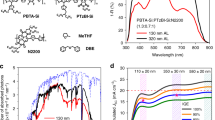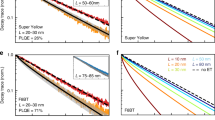Abstract
Organic solar cells have unique properties that make them very attractive as a renewable energy source. Of particular interest are semi-transparent cells, which have the potential to be integrated into building façades yet not completely block light. However, making organic cells transparent limits the metal electrode thickness to a few nanometres, drastically reducing its reflectivity and the device photon-harvesting capacity. Here, we propose and implement an ad hoc path for light-harvesting recovery to bring the photon-to-charge conversion up to almost 80% that of its opaque counterpart. We report semi-transparent PTB7:PC71BM cells that exhibit 30% visible light transmission and 5.6% power conversion efficiency. Non-periodic photonic crystals are used to trap near-infrared and near-ultraviolet photons. By modifying the layer structure it is possible to tune the device colour without significantly altering cell performance.
This is a preview of subscription content, access via your institution
Access options
Subscribe to this journal
Receive 12 print issues and online access
$209.00 per year
only $17.42 per issue
Buy this article
- Purchase on Springer Link
- Instant access to full article PDF
Prices may be subject to local taxes which are calculated during checkout





Similar content being viewed by others
References
Bailey-Salzman, R. F., Rand, B. P. & Forrest, S. R. Semitransparent organic photovoltaic cells. Appl. Phys. Lett. 88, 233502 (2006).
Ng, G.-M. et al. Optical enhancement in semitransparent polymer photovoltaic cells. Appl. Phys. Lett. 90, 103505 (2007).
Chen, F.-C., Wu, J.-L., Hsieh, K.-H., Chen, W.-C. & Lee, S.-W. Polymer photovoltaic devices with highly transparent cathodes. Org. Electron. 9, 1132–1135 (2008).
Huang, J., Li, G. & Yang, Y. A semi-transparent plastic solar cell fabricated by a lamination process. Adv. Mater. 20, 415–419 (2008).
Koeppe, R. et al. Organic solar cells with semitransparent metal back contacts for power window applications. ChemSusChem 2, 309–313 (2009).
Meiss, J. et al. Efficient semitransparent small-molecule organic solar cells. Appl. Phys. Lett. 95, 213306 (2009).
Schmidt, H. et al. Efficient semitransparent inverted organic solar cells with indium tin oxide top electrode. Appl. Phys. Lett. 94, 243302 (2009).
Tanaka, S. et al. Semitransparent organic photovoltaic cell with carbon nanotube–sheet anodes and Ga-doped ZnO cathodes. Synth. Metals 159, 2326–2328 (2009).
Bedeloglua, A., Demirb, A., Bozkurta, Y. & Sariciftci, N. S. Photovoltaic properties of polymer based organic solar cells adapted for non-transparent substrates. Renew. Energy 35, 2301–2306 (2010).
Ameri, T. et al. Fabrication, optical modeling, and color characterization of semitransparent bulk-heterojunction organic solar cells in an inverted structure. Adv. Funct. Mater. 20, 1592–1598 (2010).
Dong, Q. et al. All-spin-coating vacuum-free processed semi-transparent inverted polymer solar cells with PEDOT:PSS anode and PAH-D interfacial layer. Org. Electron. 11, 1327–1331 (2010).
Lee, J.-Y., Connor, S. T., Cui, Y. & Peumans, P. Semitransparent organic photovoltaic cells with laminated top electrode. Nano Lett. 10, 1276–1279 (2010).
Nickel, F. et al. Cathodes comprising highly conductive poly(3,4-ethylenedioxythiophene):poly(styrenesulfonate) for semi-transparent polymer solar cells. Org. Electron. 11, 535–538 (2010).
Pandey, A. K. & Samuel, I. D. W. Photophysics of solution-processed transparent solar cells under top and bottom illumination. IEEE J. Sel. Topics Quantum Electron. 16, 1560–1564 (2010).
Zhou, Y. et al. Indium tin oxide-free and metal-free semitransparent organic solar cells. Appl. Phys. Lett. 97, 153304 (2010).
Wang, X., Ng, G.-M., Ho, J.-W., Tam, H.-L. & Zhu, F. Efficient semitransparent bulk-heterojunction organic photovoltaic cells with high-performance low processing temperature indium–tin oxide top electrode. IEEE J. Sel. Topics Quantum Electron. 16, 1685–1689 (2010).
Colsmann, A. et al. Efficient semi-transparent organic solar cells with good transparency color perception and rendering properties. Adv. Energy Mater. 1, 599–603 (2011).
Lee, Y.-Y. et al. Top laminated graphene electrode in a semitransparent polymer solar cell by simultaneous thermal annealing/releasing method. ACS Nano 5, 6564–6570 (2011).
Lewis, J. E., Lafalce, E., Toglia, P. & Jiang, X. Over 30% transparency large area inverted organic solar array by spray. Solar Energy Mater. Solar Cells 95, 2816–2822 (2011).
Meiss, J., Holzmueller, F., Gresser, R., Leo, K. & Riede, M. Near-infrared absorbing semitransparent organic solar cells. Appl. Phys. Lett. 99, 193307 (2011).
Peh, R. J., Lu, Y., Zhao, F., Lee, C.-L. K. & Kwan, W. L. Vacuum-free processed transparent inverted organic solar cells with spray-coated PEDOT: PSS anode. Solar Energy Mater. Solar Cells 95, 3579–3584 (2011).
Bauer, A., Wahl, T., Hanisch, J. & Ahlswede, E. ZnO: Al cathode for highly efficient, semitransparent 4% organic solar cells utilizing TiOx and aluminum interlayers. Appl. Phys. Lett. 100, 073307 (2012).
Colsmann, A. et al. Inverted semi-transparent organic solar cells with spray coated, surfactant free polymer top-electrodes. Solar Energy Mater. Solar Cells 98, 118–123 (2012).
Kang, J.-W. et al. All-spray-coated semitransparent inverted organic solar cells: from electron selective to anode layers. Org. Electron. 13, 2940–2944 (2012).
Kim, Y. H. et al. Semi-transparent small molecule organic solar cells with laminated free-standing carbon nanotube top electrodes. Solar Energy Mater. Solar Cells 96, 244–250 (2012).
Tang, Z. et al. Semi-transparent tandem organic solar cells with 90% internal quantum efficiency. Adv. Energy Mater. 2, 1467–1476 (2012).
Kim, H. P., Lee, H. J., Yusoff, A. R. B. M. & Jang, J. Semi-transparent organic inverted photovoltaic cells with solution processed top electrode. Solar Energy Mater. Solar Cells 108, 38–43 (2013).
Tao, C. et al. Semitransparent inverted polymer solar cells with MoO3/Ag/MoO3 as transparent electrode. Appl. Phys. Lett. 95, 053303 (2009).
Shen, L. et al. Semitransparent polymer solar cells using V2O5/Ag/V2O5 as transparent anodes. Org. Electron. 12, 1223–1226 (2011).
Tao, C., Xie, G., Meng, F., Ruan, S. & Chen, W. Tailoring spatial distribution of the optical field intensity in semitransparent inverted organic solar cells. J. Phys. Chem. C 115, 12611–12615 (2011).
Winkler, T. et al. Efficient large area semitransparent organic solar cells based on highly transparent and conductive ZTO/Ag/ZTO multilayer top electrodes. Org. Electron. 12, 1612–1618 (2011).
Jin, H. et al. Efficient large area ITO-and-PEDOT-free organic solar cell sub-modules. Adv. Mater. 24, 2572–2577 (2012).
Sergeant, N. P. et al. Design of transparent anodes for resonant cavity enhanced light harvesting in organic solar cells. Adv. Mater. 24, 728–732 (2012).
Liu, Z. et al. The application of highly doped single-layer graphene as the top electrodes of semitransparent organic solar cells. ACS Nano 6, 810–818 (2012).
Krantz, J. et al. Spray-coated silver nanowires as top electrode layer in semitransparent P3HT:PCBM-based organic solar cell devices. Adv. Funct. Mater. 23, 1711–1717 (2013).
Guo, F. et al. ITO-free and fully solution-processed semitransparent organic solar cells with high fill factors. Adv. Energy Mater. 3, 1062–1067 (2013).
Lunt, R. R. & Bulovic, V. Transparent, near-infrared organic photovoltaic solar cells for window and energy-scavenging applications. Appl. Phys. Lett. 98, 113305 (2011).
Yu, W. et al. Simultaneous improvement in efficiency and transmittance of low bandgap semitransparent polymer solar cells with one-dimensional photonic crystals. Solar Energy Mater. Solar Cells 117, 198–202 (2013).
O'Brien, P. G. et al. Selectively transparent and conducting photonic crystal rear-contacts for thin-film silicon-based building integrated photovoltaics. Opt. Express 19, 17040 (2011).
Galagan, Y., Debije, M. G. & Blom, P. W. M. Semitransparent organic solar cells with organic wavelength dependent reflectors. Appl. Phys. Lett. 98, 043302 (2011).
Chen, C.-C. et al. Visibly transparent polymer solar cells produced by solution processing. ACS Nano 6, 7185–7190 (2012).
Dou, L. et al. A selenium-substituted low-bandgap polymer with versatile photovoltaic applications. Adv. Mater. 25, 825–831 (2013).
Meiss, J. et al. Highly efficient semitransparent tandem organic solar cells with complementary absorber materials. Appl. Phys. Lett. 99, 043301 (2011).
Chen, K.-S. et al. Semi-transparent polymer solar cells with 6% PCE, 25% average visible transmittance and a color rendering index close to 100 for power generating window applications. Energy Environ. Sci. 5, 9551–9557 (2012).
Chueh, C.-C. et al. Toward high-performance semi-transparent polymer solar cells: optimization of ultra-thin light absorbing layer and transparent cathode architecture. Adv. Energy Mater. 3, 417–423 (2013).
Lunt, R. R. Theoretical limits for visibly transparent photovoltaics. Appl. Phys. Lett. 101, 043902 (2012).
He, Z. et al. Enhanced power-conversion efficiency in polymer solar cells using an inverted device structure. Nature Photon. 6, 591–595 (2012).
Martínez-Otero, A., Elias, X., Betancur, R. & Martorell, J. High performance polymer solar cells using an optically enhanced architecture. Adv. Opt. Mater. 1, 37–42 (2013).
Betancur, R. et al. Optical interference for the matching of the external and internal quantum efficiencies in organic photovoltaic cells. Solar Energy Mater. Solar Cells 104, 87–91 (2012).
Acknowledgements
The authors acknowledge support from the Ministerio de Economía y Competitividad (grants MAT2011-28665, IPT-120000-2010-29, IPT-2012-0986-120000 and CSD2007-00046).
Author information
Authors and Affiliations
Contributions
R.B. and P.R.-G. contributed equally in the optical simulation, design and fabrication of the transparent organic cells, including the non-periodic photonic crystal. R.B., P.R.-G., A.M.-O. and X.E. contributed to the optimization and fabrication of the organic devices. R.B., P.R.-G., A.M.-O. and M.M. contributed to the fabrication of the transparent electrode. The project was planned and supervised by J.M. The manuscript was written by J.M. with the assistance of all other authors.
Corresponding author
Ethics declarations
Competing interests
The authors declare no competing financial interests.
Supplementary information
Supplementary information
Supplementary information (PDF 2910 kb)
Rights and permissions
About this article
Cite this article
Betancur, R., Romero-Gomez, P., Martinez-Otero, A. et al. Transparent polymer solar cells employing a layered light-trapping architecture. Nature Photon 7, 995–1000 (2013). https://doi.org/10.1038/nphoton.2013.276
Received:
Accepted:
Published:
Issue Date:
DOI: https://doi.org/10.1038/nphoton.2013.276
This article is cited by
-
Achieving sustainability of greenhouses by integrating stable semi-transparent organic photovoltaics
Nature Sustainability (2023)
-
Semitransparent organic photovoltaics for building-integrated photovoltaic applications
Nature Reviews Materials (2022)
-
Fabrication of near-invisible solar cell with monolayer WS2
Scientific Reports (2022)
-
Enhancement of color and photovoltaic performance of semi-transparent organic solar cell via fine-tuned 1D photonic crystal
Scientific Reports (2022)
-
The principles, design and applications of fused-ring electron acceptors
Nature Reviews Chemistry (2022)



